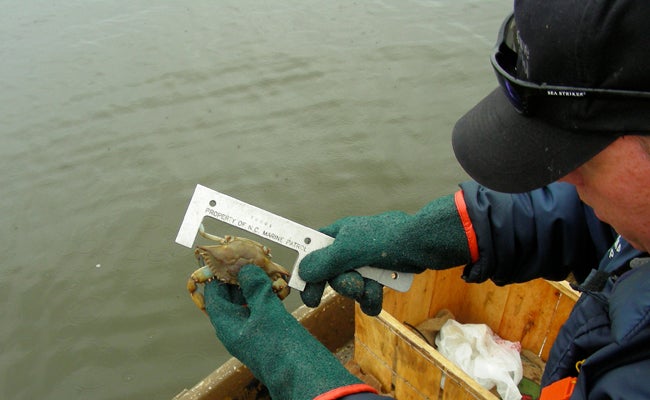Using live blue crabs as bait may be illegal
Published 11:02 am Friday, May 22, 2015

FRED BONNER | CONTRIBUTED
CAUGHT CRAB HANDED: This Enforcement Officer checks the size a blue crab that was taken by a commercial fisherman to be sure that it meets the legal requirements that the N.C. law requires of ALL fishermen, recreational or commercial.
On a recent trip to the Gulf Coast of Texas, I was talking with a fisherman who was noted for his ability to catch large redfish (red drum) and asked him what this secret was. His reply surprised me somewhat. I had always surmised that redfish anglers who were noted for taking these renowned sport fish were dedicated to using artificial lures.
“If I were to chose any bait for consistently taking redfish, it would always be by using a live, two- to four-inch blue crab for bait. Redfish will simply knock themselves out to get to one of these small, live crabs.”
I’d known for years that deadly bait for most kinds of predatory fish in our brackish waters was either using soft or peeler crab parts fished on the bottom. There was something about the smell of this type of bait that drove fish crazy. If this bait from a molting crab could be good, why shouldn’t a regular hard crab be equally good?
The Texas angler further replied that he looked for feeding redfish in the grass beds that you frequently find in the shallow bays along the Gulf Coast.
“Grass beds are usually full of items that redfish and speckled trout feed on and these grassy areas are like fast food restaurants to redfish. Shrimp, crabs and small baitfish find refuge in these natural grass beds and that’s where the redfish go when they’re hungry. It may be shallow and you have to literally sneak up quietly on the feeding fish and carefully cast your bait to them.”
When I asked him how he rigged the live crab as bait, he replied that, “I use a circle hook and, dependent on the size of the crab you’re using as bait, insert the point of the hook through the bottom of the horn of the crab’s shell and work the point of the hook out through the top of the shell of the horn (sharp tip of the carapace). Be sure that the hook extends out of the shell far enough to let the hook engage the fish’s mouth when you set the hook. Don’t run the hook too deeply into the crab’s body or you might kill the crab. You want this kind of bait to be alive because, just as with a live shrimp or minnow, the struggling bait emits vibrations that attract predatory fish.”
A live hard crab as bait sounded like a very good tip, but when I thought about it, I began to wonder whether or not the use of a small blue crab as a live bait was legal in our North Carolina waters. After all, recreational and commercial crabbers do have certain size and sex limits on the blue crabs that they harvest.
A lengthy call to the North Carolina Division of Marine Fisheries finally resulted in an answer to the question of using sub-legal sized crabs as live bait. One of the DMF enforcement officers informed me that sport fishermen who might use small blue crabs as a live bait need to comply with the same size limit regulations as both the recreational and commercial crabbers’ guidelines. The listed regulations for recreational crabbing are as follows:
• 5-inch minimum size limit for males and immature females.
• 6 3⁄4 -inch maximum size limit for females from Sept. 1-April 30
• 50 crabs per day per person, not to exceed 100 crabs per vessel per day.
• Size limit is measured from tip-to-tip of the carapace
After talking to the N.C. Division of Marine Fisheries and having spent some time on the internet trying to sort out all the laws and regulations having to do with blue crabs, it would be illegal in North Carolina to use small blue crab as bait. What might be legal for the Texas redfish angler will not work for a Tar Heel angler.
We sport fishermen frequently complain about having too much aquatic grass, such as widgeon grass in our brackish water. It makes it hard to retrieve a lure through the grass without getting it tangled on the hook. On the other hand, the vegetation is a very definite benefit to the juvenile fish, crabs, shrimp and other estuarine organisms.
The Texas angler places a lot of emphasis on his success at catching nice redfish on not only the use of small blue crabs as bait, but also on the availability of grass as well. He often finds his best fishing in water that’s only a foot or so in depth. “Find the bait and you’ll find the fish” is his rule of thumb.
Aquatic vegetation is also responsible for the clarity of the water where he (and the fish) finds the best habitat. He felt that the vegetation adsorbs a lot of the nutrients that tend to make the water cloudy and clear water makes for better fishing.





